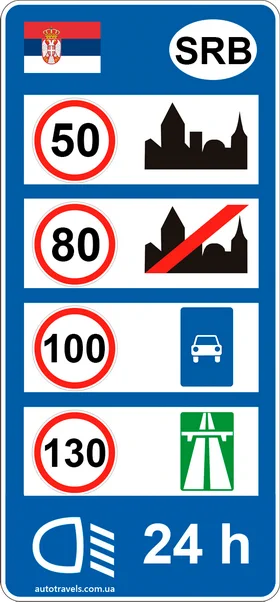
 Serbia
Serbia
- TitleColor: #333333
- DateColor: #999999
- SizeFont: 60
- FlagImg URL: /images/flags/Flag_of_Serbia.svg
- TitleImageSizes: 1900,1440,720
Serbia – Contents
General Information Toll Roads Speed Limits Headlights Petrol Parking Insurance Car Equipment Child Transportation TiresGeneral Information
Details about roads, speed limits, mandatory car equipment, and some traffic rule requirements. Below sections provide more detailed information on toll roads, petrol costs, parking, speed limits, etc.
| Payment for roads based on the distance traveled at special control points | |
 |
In populated areas – 50 km/h Outside populated areas – 80 km/h Motorway – 100 km/h Freeway – 130 km/h Mandatory use of headlights |
| Maximum blood alcohol level 0.2 ‰ Talking on the phone while driving is prohibited |
|
| Winter tires mandatory from Nov 1 to Apr 1, Tire chains allowed on snow from Nov 1 to Mar 1, Studded tires are prohibited |
|
Mandatory equipment:
|
|
| Seat belts are mandatory for all passengers Child seats/boosters are mandatory for children under 12 years old and with a height up to 135 cm |
Toll Roads
In Serbia, there is a charge for certain road sections, and the fee depends on the vehicle category.
Vehicle Categories
| Vehicle Type | Category | Description |
|---|---|---|
| IA | Motorcycles, quads | |
| I | Vehicles with 2 axles and a height up to 1.3 m in the area of the first axle Vehicles with 2 axles, total height up to 1.9 m, and a maximum permissible weight of up to 3.5 t |
|
| II | Vehicles with 2 axles and a height up to 1.3 m in the area of the first axle with a trailer Vehicles with 2 axles, total height up to 1.9 m, and a maximum permissible weight of up to 3.5 t with a trailer Vehicles with 2 axles, total height over 1.9 m, and a maximum permissible weight of up to 3.5 t |
|
| III | Vehicles with 2 or 3 axles and a height over 1.3 m in the area of the first axle and a maximum permissible weight over 3.5 t Vehicles with 2 axles, total height over 1.9 m, and a maximum permissible weight of up to 3.5 t with a trailer |
Toll Rates for Serbian Motorways Sections
A route from the Hungary border to the North Macedonia border (~570 km) for a passenger car will cost 2090 RSB (€18).
| Section | Category IA | Category I | Category II | Category III | |
|---|---|---|---|---|---|
| E70 | Belgrade - Šid | 210 (€ 2) | 410 (€ 3.5) | 640 (€ 5.5) | 1,270 (€ 11) |
| E75 | Belgrade - Subotica | 320 (€ 3) | 630 (€ 5.5) | 940 (€ 8) | 1,870 (€ 16) |
| E75 | Belgrade - Preševo | 730 (€ 6.5) | 1460 (€ 12.5) | 2190 (€ 19) | 4380 (€ 37.5) |
| E763 | Belgrade - Čacak | 210 (€ 2) | 420 (€ 4) | 630 (€ 5.5) | 1250 (€ 11) |
| E80 | Nish - Dimitrovgrad | 210 (€ 2) | 410 (€ 3.5) | 620 (€ 5.5) | 1240 (€ 10.5) |
Payment of Serbian Motorways
Payment for highways in Serbia can be made at toll booths with cash in Serbian dinars (RSD) or by bank card. Cash payments in euros are also accepted, including 1 and 2 euro coins, as well as 50 cents. Coins of 10 and 20 cents are not accepted. Change can be given in both the national currency and euros.
The toll rates in euros are fixed, and there is no conversion from dinars (RSD) at the current exchange rate. While there is no significant difference in the currency of payment, it is recommended to pay in Serbian dinars.
An electronic device (TAG) allows seamless passage through toll booths, but no discounts are provided for using these devices. The cost of the TAG is approximately 17 euros.
Serbian Roads website: https://www.putevi-srbije.rs/index.php/en/
Map of toll roads in Serbia
Speed Limits

Standard speed limits in Serbia (unless indicated otherwise on road signs).
Cars and motorcycles:- In populated areas – 50 km/h
- Outside populated areas – 80 km/h
- On roads – 100 km/h
- On highways – 130 km/h
Cars with trailers:
- In populated areas – 50 km/h
- Outside populated areas – 80 km/h
- On roads – 80 km/h
- On highways – 80 km/h
The minimum speed on highways is 50 km/h
Headlights
Low beam headlights are mandatory 24 hours a day, all year round.
During daylight hours (from sunrise to sunset) and under normal visibility conditions, daytime running lights can be used instead of low beam headlights.
Low beam headlights are also mandatory in tunnels.
Cost of Petrol in Serbia
Mandatory Equipment
Equipment required to have in the car:| Emergency stop sign | |
| First aid kit | |
| Fire extinguisher | |
| Reflective vest – A reflective vest is mandatory for anyone exiting the vehicle, during the day or night, in case of a stop or accident. The vest should be in the car, not in the trunk. | |
| Set of spare lamps | |
| Spare wheel | |
| Tow rope |
Child Transportation
Children under 3 years old can be transported in a child seat on the front seat, but it must be installed facing the opposite direction of the car's movement, and the front airbag must be deactivated.
Children aged 3 to 12 years and with a height of up to 135 cm must be transported only in the rear seats using special restraint systems attached to the vehicle.
Winter Tires, Studded Tires, Chains
| Winter tires are mandatory from November 1 to April 15 if the road is covered with snow or ice. | |
It is recommended to have chains, and they should be used when a special road sign is installed and when the road is completely covered with snow during the period from November 1 to March 1.
 |
|
| Use of studded tires is prohibited. |
 travels
travels Albania
Albania Andorra
Andorra Austria
Austria Azerbaijan
Azerbaijan Belarus
Belarus Belgium
Belgium Bosnia and Herzegovina
Bosnia and Herzegovina Bulgaria
Bulgaria Croatia
Croatia Cyprus
Cyprus Czech Republic
Czech Republic Denmark
Denmark Estonia
Estonia Finland
Finland France
France Georgia
Georgia Germany
Germany Greece
Greece Hungary
Hungary Iceland
Iceland Ireland
Ireland Italy
Italy Kosovo
Kosovo Latvia
Latvia Liechtenstein
Liechtenstein Lithuania
Lithuania Luxembourg
Luxembourg Malta
Malta Moldova
Moldova Monaco
Monaco Montenegro
Montenegro Netherlands
Netherlands North Macedonia
North Macedonia Norway
Norway Poland
Poland Portugal
Portugal Romania
Romania Russia
Russia San Marino
San Marino Slovakia
Slovakia Slovenia
Slovenia Spain
Spain Sweden
Sweden Switzerland
Switzerland Turkey
Turkey Ukraine
Ukraine United Kingdom
United Kingdom